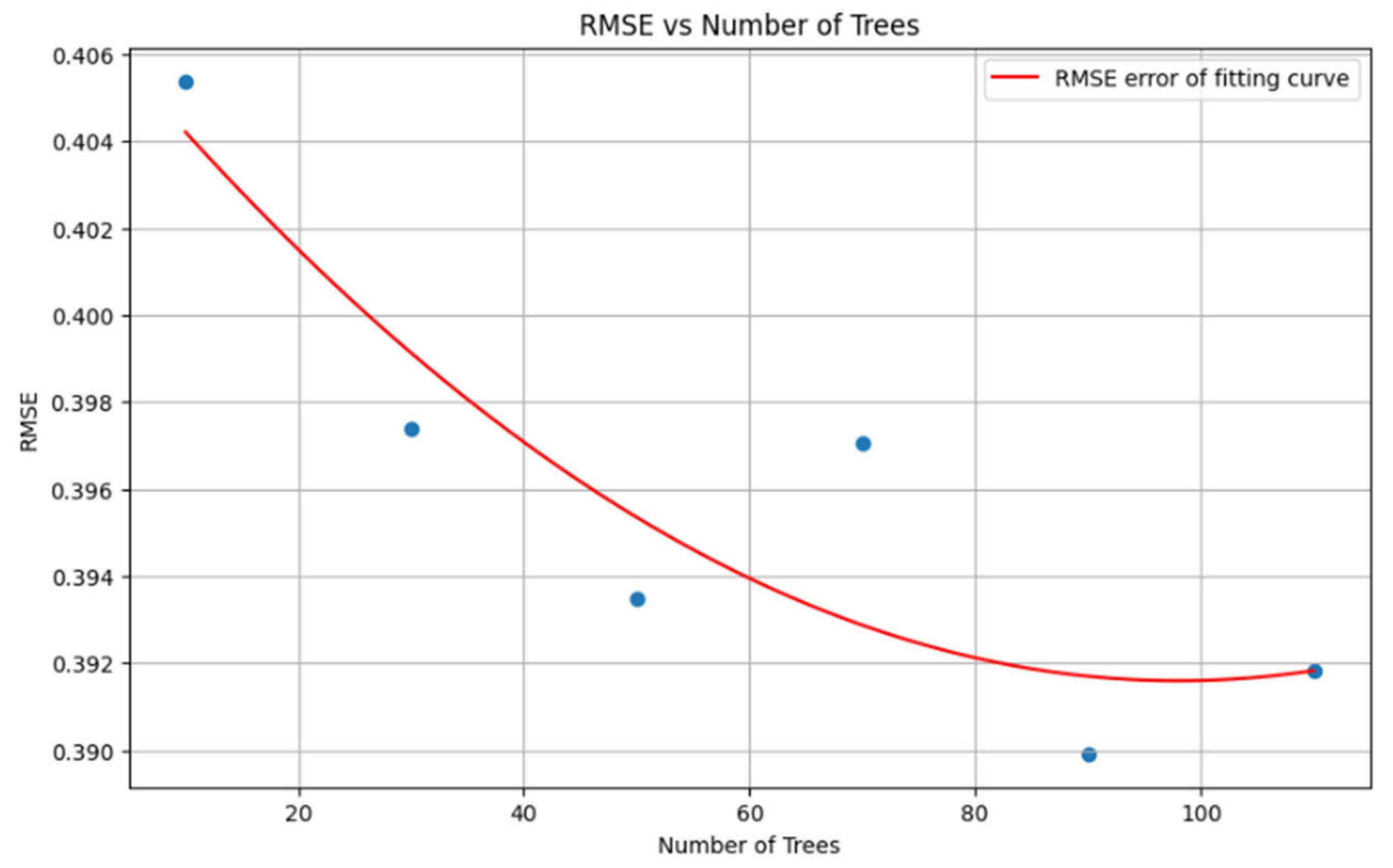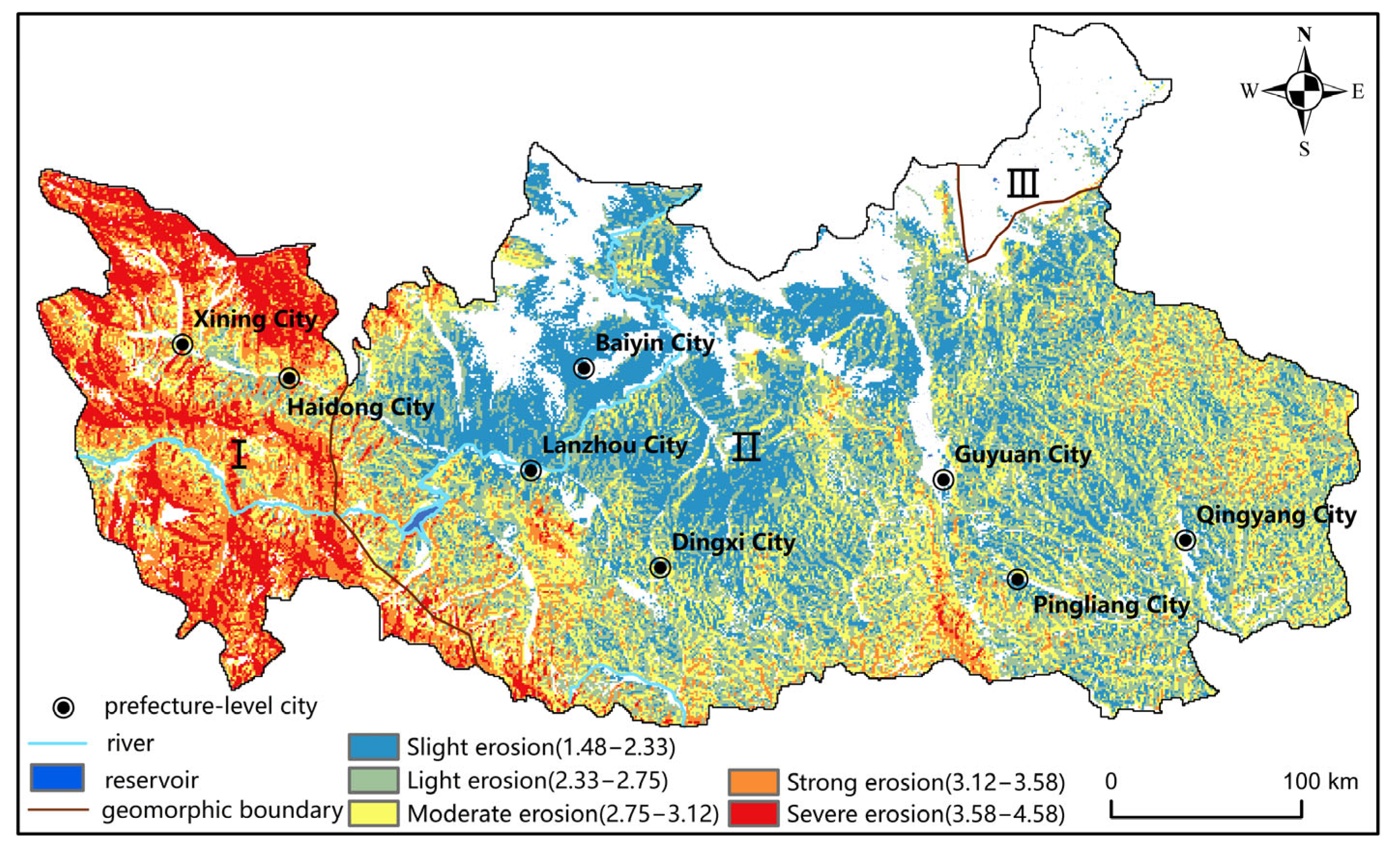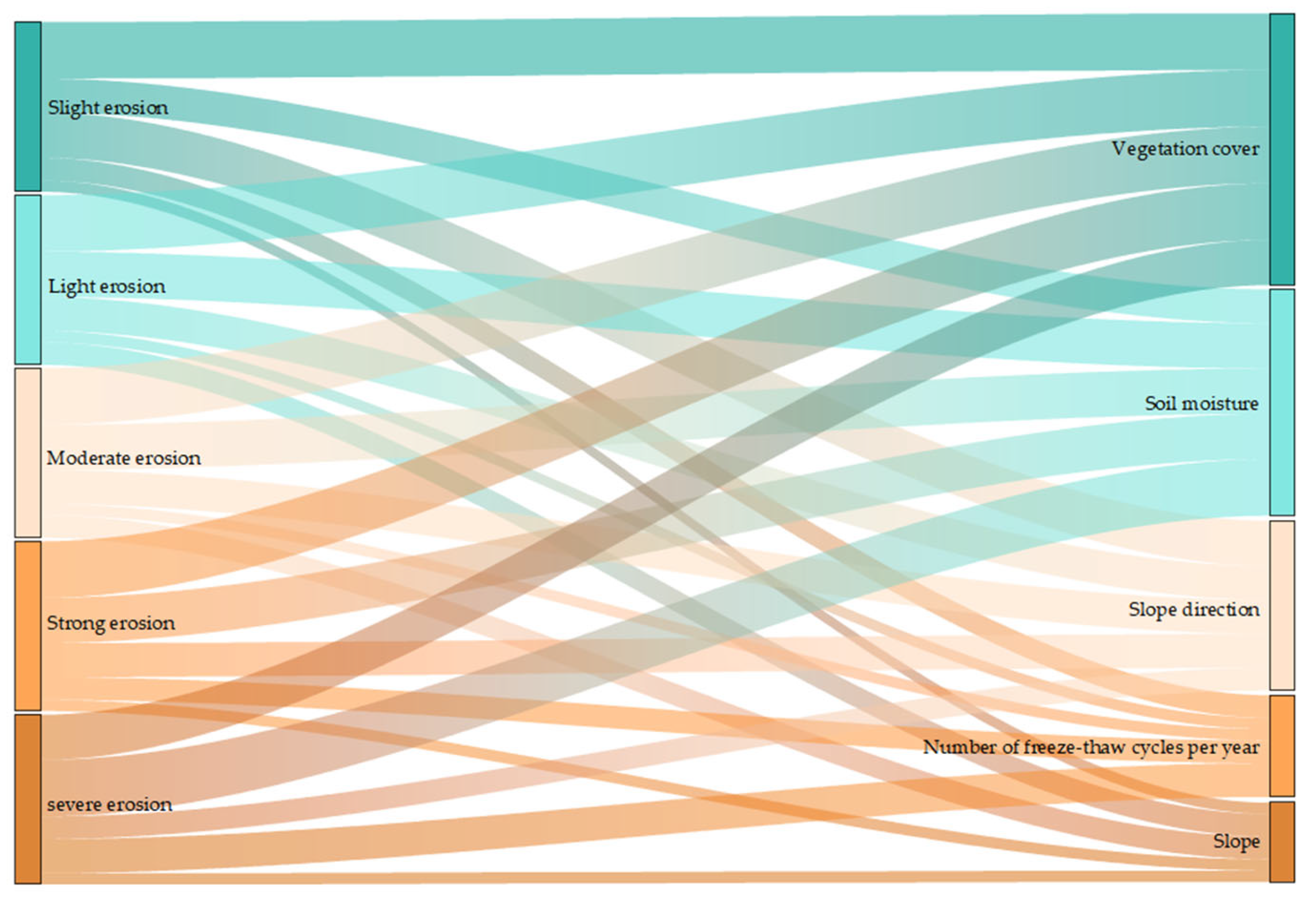Delineation and Intensity Classification of Freeze–Thaw Erosion in the Western Section of Northern China’s Agro-Pastoral Transition Zone Under Controlling Factors
Abstract
1. Introduction
2. Materials and Methods
2.1. Overview of the Study Area
2.2. Data Sources
2.3. Delineation of the Freeze–Thaw Erosion Zone
2.4. Freeze-Thaw Erosion Intensity Evaluation System
2.4.1. Method for Calculating the Comprehensive Evaluation Index
2.4.2. Graded Evaluation Indicators and Standards
2.4.3. Weighting of Comprehensive Evaluation Index and Classification of Erosion Intensity
3. Results
3.1. Spatial Distribution Characteristics of Freeze–Thaw Erosion Zones
3.2. Spatial Distribution of Freeze-Thaw Erosion Intensity
4. Discussion
4.1. Controlling Factors of Freeze–Thaw Erosion
4.2. Factors Affecting Freeze–Thaw Erosion Resistance
4.3. Strategies for the Prevention and Control of Soil Freeze–Thaw Erosion
5. Conclusions
Supplementary Materials
Author Contributions
Funding
Data Availability Statement
Acknowledgments
Conflicts of Interest
References
- Sun, B.; Wu, Z.; Li, Z.; Liu, J.; Xiao, J.; Cheng, D.; Ren, F.; Ma, J.; Liu, C.; Ma, B. Effects of freeze-thaw on soil detachment capacity and erosion resistance. Trans. Chin. Soc. Agric. Eng. 2020, 36, 57–65. [Google Scholar] [CrossRef]
- Lu, Y.; Liu, C.; Ge, Y.; Hu, Y.; Wen, Q.; Fu, Z.; Wang, S.; Liu, Y. Spatiotemporal characteristics of freeze-thaw erosion in the source regions of the Chin-Sha, Ya-Lung and Lantsang Rivers on the basis of GIS. Remote Sens. 2021, 13, 309. [Google Scholar] [CrossRef]
- Yan, S.; Li, X.; Liu, Z. Research progress and prospects of compound soil erosion in the black soil region of Northeast China. Chin. Agric. Sci. Bull. 2024, 40, 96–101. [Google Scholar] [CrossRef]
- Pei, X. Disturbance mechanism of major engineering geological environment and ecological restoration technology system in the Qinghai-Tibet Plateau. J. Eng. Geol. 2024, 32, 1737–1758. [Google Scholar] [CrossRef]
- Wang, J.; Xu, X.; Liu, P. Land use and land carrying capacity in ecotone between agriculture and animal husbandry in Northern China. Resour. Sci. 1999, 21, 21–26. [Google Scholar] [CrossRef]
- Dong, R.K.; Xu, Z.Y.; Yang, C.Y. Dynamic and characteristic of freezing-thawing erosion on Qinghai-Tibet Plateau. J. Soil Water Conserv. 2000, 14, 12–16. [Google Scholar] [CrossRef]
- Li, J.; Wang, G.; Song, C.; Sun, S.; Ma, J.; Wang, Y.; Guo, L.; Li, D. Recent intensified erosion and massive sediment deposition in Tibetan Plateau rivers. Nat. Commun. 2024, 15, 722. [Google Scholar] [CrossRef]
- Yang, W.; Zhang, G.; Yang, H.; Lin, D.; Shi, P. Review and prospect of soil compound erosion. J. Arid Land 2023, 15, 1007–1022. [Google Scholar] [CrossRef]
- Zhang, J.; Liu, S. Methodologies and technologies of the implementation of Erhai Lake valley management system. Geogr. Geo-Inf. Sci. 2005, 21, 32–34+47. [Google Scholar] [CrossRef]
- Cui, J.; Xin, Z.; Huang, Y. The spatiotemporal variations in freeze-thaw erosion in 2003-2020 on the Qinghai-Tibet Plateau. Acta Ecol. Sin. 2023, 43, 4515–4526. [Google Scholar] [CrossRef]
- Li, D.; Wei, X.; Li, X.G.; Li, Y.J. Sensitivity evaluation of freeze-thaw erosion in gansu province based on RS and GIS. Res. Soil Water Conserv. 2015, 22, 1–6. [Google Scholar] [CrossRef]
- Li, Z.; Liu, S.; Zhang, J.; Zhang, L. Investigation methods of freeze-thaw erosion in China. Sci. Soil Water Conserv. 2012, 10, 1–5. [Google Scholar] [CrossRef]
- Shi, Z.; Tao, H.; Liu, S.; Liu, B.; Guo, B. Research of freeze-thaw erosion in the Three-River-Source area based on GIS. Trans. Chin. Soc. Agric. Eng. 2012, 28, 214–221. [Google Scholar] [CrossRef]
- Shen, Q.; Liu, X.; Zhou, X.; Zhang, Z.; Chen, Q. Spatiotemporal patterns of daily freeze-thaw cycles in near-surface soil on the Qinghai-Tibet Plateau from 2002 to 2020. Acta Geogr. Sin. 2023, 78, 587–603. [Google Scholar] [CrossRef]
- Luo, L.; Pei, X.; Huang, R.; Pei, Z. Spatial-temporal differentiation characteristics and rate of freeze-thaw erosion of rock slopes in periglacial area. J. Eng. Geol. 2020, 28, 1319–1328. [Google Scholar] [CrossRef]
- Zhang, K.; Liu, H. Research progresses and prospects on freeze-thaw erosion in the black soil region of Northeast China. Sci. Soil Water Conserv. 2018, 16, 17–24. [Google Scholar] [CrossRef]
- Gao, C.; Yao, J.; Li, P.; Mu, X. Research progress on gravitational erosion in the Loess Plateau. Yellow River 2020, 42, 99–105. [Google Scholar] [CrossRef]
- Jin, C. The role of slope gradient in slope erosion. Geogr. Res. 1996, 15, 57–63. [Google Scholar]
- Yu, L.; Xu, X.; Zhang, M.; Liu, G. Sensitivity analysis of gravitational erosion to geomorphic factors on the Loess Plateau. J. Soil Water Conserv. 2019, 33, 119–125. [Google Scholar] [CrossRef]
- Hu, S.; Jin, C. Theoretical and experimental study on the critical slope gradient of hillslope soil erosion. Acta Geogr. Sin. 1999, 54, 61–70. [Google Scholar] [CrossRef]
- Yang, J.; Zheng, M.; Yao, W.; Wang, L. Analysis of topographic factors for gravitational erosion in loess gullies. Soil Water Conserv. China 2014, 8, 42–45, 69. [Google Scholar] [CrossRef]
- Gao, J.; Ai, Q.; Han, L.; Gao, L.; Yang, L.; Ma, S.; Zhang, Y. An observation-based dataset of gravity erosion of Xindiangou watershed in the first sub-region of Loess Hilly-Gully Region during 2017–2018. China Sci. Data 2021, 6, 113–120. [Google Scholar] [CrossRef]
- Xing, S.; Zhang, G.; Wang, Z.; Wang, L. Morphological characteristics and critical topographic thresholds of shallow landslides and collapses in the loess hilly-gully region. J. Soil Water Conserv. 2022, 36, 106–113. [Google Scholar] [CrossRef]
- Qin, S.; Duan, B.; Wang, H.; Li, M.; Wei, C. Characteristics and distribution patterns of geo-hazards in the Jinchuan reach of the Dadu River. J. Yangtze River Sci. Res. Inst. 2023, 40, 179–186. [Google Scholar] [CrossRef]
- Li, E.D.; Yang, Q.K.; Pang, G.W.; Wang, C.M.; Yang, L.J.; Qiao, B.J. Spatial pattern and influencing factors of slope length and steepness factors (LS) in Qinghai-Tibet Plateau. J. Soil Water Conserv. 2023, 37, 133–139. [Google Scholar] [CrossRef]
- Yang, Z.; Ni, W.; Li, L.; Niu, F. Multi-factor classification and evaluation of soil freeze-thaw erosion intensity based on GIS: A case study in the upper reaches of the Yangtze River. J. Water Resour. Archit. Eng. 2022, 20, 89–95. [Google Scholar] [CrossRef]
- Li, H.; Xu, E.; Zhang, H. Soil erosion regionalization in Ili River Valley. Chin. J. Agric. Resour. Reg. Plan. 2018, 39, 116–124. (In Chinese) [Google Scholar]
- Guo, B.; Jiang, L. Evaluation of freeze-thaw erosion in Qinghai-Tibet Plateau based on multi-source data. Bull. Soil Water Conserv. 2017, 37, 12–19. [Google Scholar] [CrossRef]
- Sun, Z.F.; Song, C.F.; Li, W.S.; Chen, D. On erosion mechanism and control measures of freezing and thawing. J. Heilongjiang Hydraul. Eng. Coll. 1999, 26, 34–35. [Google Scholar] [CrossRef]
- Gu, Y.Q.; Huang, Y.J.; Wei, X.W. Analysis of freeze-thaw erosion factors in the north diversion channel. Heilongjiang Sci. Technol. Water Conserv. 2004, 31, 37. [Google Scholar] [CrossRef]
- Cai, L.; Fang, X.; Lv, S.; Zhang, Y.; Li, Z.; Zhang, S.; Lai, X. Variations in freeze-thaw intensity and its relationship with air temperature in the central Qinghai-Tibet Plateau. Plateau Meteorol. 2021, 40, 244–256. [Google Scholar] [CrossRef]
- Wang, W.; Wang, B.; Gu, W.; Chen, Z.; Jiang, Y. Effect of freeze-thaw cycles on soil aggregate stability and microstructure of black soil. J. Soil Water Conserv. 2022, 36, 66–73. [Google Scholar] [CrossRef]
- Lan, A.; Lin, Z.; Fan, X.; Yao, M. Differences of surface energy and shallow soil temperature and humidity at sunny and shady slopes in permafrost region, Beiluhe Basin, Qinghai-Tibet Plateau. Adv. Earth Sci. 2021, 36, 962–979. [Google Scholar] [CrossRef]
- Li, Q.; Yang, J.; Zhang, J.; Kang, F.; Gao, Y.; Zhang, Z. Progress of research on soil erosion resistance of plant roots and future prospects. J. Agric. Resour. Environ. 2020, 37, 17–23. [Google Scholar] [CrossRef]
- Wang, X.; Huang, S.; Li, T.; Qi, Z.; Hu, Y.; Li, K.; Yan, X. Research on the soil reinforcement effects of vegetation buffer zone—A case study of the Tongnan section of the Fujiang River Basin. Sci. Soil Water Conserv. 2025, 23, 199–209. [Google Scholar] [CrossRef]
- Wang, J.; Zhang, X.; Gulimire, P.; Wang, Z. Classification evaluation and spatial distribution characteristics of freeze-thaw erosion intensity in Heilongjiang Province of China. Trans. Chin. Soc. Agric. Eng. 2024, 40, 168–176. [Google Scholar] [CrossRef]
- Gao, G.; Liang, Y.; Liu, J.; Dunkerley, D.; Fu, B. A modified RUSLE model to simulate soil erosion under different ecological restoration types in the loess hilly area. Int. Soil Water Conserv. Res. 2024, 12, 258–266. [Google Scholar] [CrossRef]
- Hu, C.Q.; Ma, Y.; Huang, X.D.; Zhao, L. Downscaling algorithm for AMSR2 land surface temperature over the Tibetan Plateau using random forest. Pratacultural Sci. 2025, 42, 11–22. [Google Scholar] [CrossRef]
- Wu, W.; Liu, F. Dynamic analysis and distribution characteristics of freeze-thaw erosion in the Three-Rivers’ Headstream Region. J. Qinghai Norm. Univ. (Nat. Sci.) 2010, 26, 57–61. [Google Scholar] [CrossRef]
- Huang, H.; Tian, Y.; Liu, J.; Zhang, J.; Yang, D.; Yang, S. The mechanism and sensitivity analysis of soil freeze-thaw erosion on slope in eastern Tibet. Acta Geogr. Sin. 2021, 76, 87–100. [Google Scholar] [CrossRef]
- Fan, H.; Cai, Q. Review of research progress in freeze-thaw erosion. Sci. Soil Water Conserv. 2003, 1, 50–55. [Google Scholar] [CrossRef]
- Jing, G.; Ren, X.; Liu, X.; Liu, B.; Zhang, L.; Yang, Y.; Wang, Y. Relationship between freeze-thaw action and soil moisture for Northeast Black soil region of China. Sci. Soil Water Conserv. 2008, 6, 32–36. [Google Scholar] [CrossRef]
- Wang, L.; Xiao, Y.; Jiang, L.; Ouyang, Z. Assessment and analysis of the freeze-thaw erosion sensitivity on the Tibetan Plateau. J. Glaciol. Geocryol. 2017, 39, 61–69. (In Chinese) [Google Scholar]
- Patton, A.I.; Rathburn, S.L.; Capps, D.M. Landslide response to climate change in permafrost regions. Geomorphology 2019, 340, 116–128. [Google Scholar] [CrossRef]







| Index | Tiered Assignment | ||||
|---|---|---|---|---|---|
| 1 | 2 | 3 | 4 | 5 | |
| Annual freeze–thaw cycle days/day | <94 | 94–109 | 109–130 | 130–149 | 149–185 |
| Soil moisture/(m3/m3) | 0.15–0.21 | 0.21–0.26 | 0.26–0.30 | 0.30–0.34 | 0.34–0.39 |
| Slope/(°) | 0–8 | 8–16 | 16–24 | 24–33 | 33–82 |
| Vegetation cover/% | >78 | 58–78 | 37–58 | 14–37 | 0–14 |
| Slope direction/(°) | 0–22.5 | 22.5–67.5 | 67.5–112.5 | 112.5–157.5 | 157.5–202.5 |
| 337.5–360 | 292.5–337.5 | 247.5–292.5 | 202.5–247.5 | ||
| Project | Number of Freeze–Thaw Cycles Per Year | Soil Moisture | Slope | Vegetation Cover | Slope Direction |
|---|---|---|---|---|---|
| Weight | 0.1590 | 0.2472 | 0.1676 | 0.2090 | 0.2171 |
| Freeze–Thaw Erosion Intensity | Minor Degree | Mild | Moderate | Intensity | Violent |
|---|---|---|---|---|---|
| Comprehensive Evaluation Index | 1.48–2.33 | 2.33–2.75 | 2.75–3.12 | 3.12–3.58 | 3.58–4.58 |
| Freeze–Thaw Erosion Intensity | Total Area (104 km2) | Percentage of Freeze–Thaw Erosion Area (%) |
|---|---|---|
| Slight erosion | 1.48 | 12.13 |
| Light erosion | 3.27 | 26.68 |
| Moderate erosion | 4.83 | 39.42 |
| Strong erosion | 1.09 | 8.87 |
| Severe erosion | 1.58 | 12.90 |
Disclaimer/Publisher’s Note: The statements, opinions and data contained in all publications are solely those of the individual author(s) and contributor(s) and not of MDPI and/or the editor(s). MDPI and/or the editor(s) disclaim responsibility for any injury to people or property resulting from any ideas, methods, instructions or products referred to in the content. |
© 2025 by the authors. Licensee MDPI, Basel, Switzerland. This article is an open access article distributed under the terms and conditions of the Creative Commons Attribution (CC BY) license (https://creativecommons.org/licenses/by/4.0/).
Share and Cite
Ma, X.; Ma, W.; Liu, F.; Chen, Q.; Niu, B.; Zhou, Q. Delineation and Intensity Classification of Freeze–Thaw Erosion in the Western Section of Northern China’s Agro-Pastoral Transition Zone Under Controlling Factors. Land 2025, 14, 2278. https://doi.org/10.3390/land14112278
Ma X, Ma W, Liu F, Chen Q, Niu B, Zhou Q. Delineation and Intensity Classification of Freeze–Thaw Erosion in the Western Section of Northern China’s Agro-Pastoral Transition Zone Under Controlling Factors. Land. 2025; 14(11):2278. https://doi.org/10.3390/land14112278
Chicago/Turabian StyleMa, Xiaoyan, Weidong Ma, Fenggui Liu, Qiong Chen, Baicheng Niu, and Qiang Zhou. 2025. "Delineation and Intensity Classification of Freeze–Thaw Erosion in the Western Section of Northern China’s Agro-Pastoral Transition Zone Under Controlling Factors" Land 14, no. 11: 2278. https://doi.org/10.3390/land14112278
APA StyleMa, X., Ma, W., Liu, F., Chen, Q., Niu, B., & Zhou, Q. (2025). Delineation and Intensity Classification of Freeze–Thaw Erosion in the Western Section of Northern China’s Agro-Pastoral Transition Zone Under Controlling Factors. Land, 14(11), 2278. https://doi.org/10.3390/land14112278





